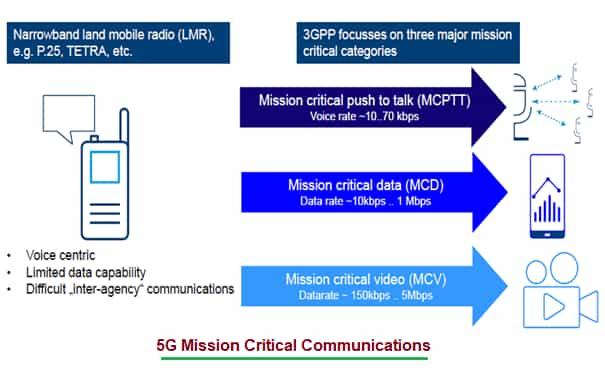5G Mission Critical Communication: Benefits & Drawbacks
Advertisement
Introduction : The advent of 5G technology has revolutionized the landscape of communication, bringing unprecedented speed, reliability, and connectivity. Among its most impactful applications is Mission Critical Communication (MCX). It is the 3rd Generation Partnership Project’s (3GPP) official framework for providing highly reliable, secure, and high performance communications over 5G networks for public safety, first responders and critical industries (like utilities and transportation).
What is 5G Mission Critical Communication (MCX)?
5G enabled MCX combines ultra low latency, high data throughput and network slicing capabilities to ensure seamless communication even under extreme conditions.
5G Mission Critical Communication (MCX) represents a fundamental evolution from the legacy Land Mobile Radio (LMR) systems (e.g., P.25, TETRA) that have been the standard for decades.
Following are major limitations encountered by LMR systems.
- They were primarily voice centric (like a walkie-talkie).
- They had very limited data capabilities.
- They operated in silos, making it difficult for different agencies (e.g., police, fire and paramedics) to communicate with each other seamlessly during a major incident.
5G MCX transforms this by leveraging the full power of the 5G architecture to create a unified platform for three core services:
- MC PTT (Mission Critical Push to Talk): The modern, IP based evolution of two way radio voice communication, offering superior quality and features.
- MC Data (Mission Critical Data): Provides the ability to reliably send and receive critical data in the field, such as building floor plans, suspect information or patient medical records.
- MC Video (Mission Critical Video): Enables the secure, real time streaming of video from the scene, for example, from a body worn camera, a drone or a vehicle dashboard camera.
 Image Courtesy : Rohde & Schwarz
Image Courtesy : Rohde & Schwarz
Benefits of 5G Mission Critical Communication (MCX)
The move from LMR to 5G MCX offers a transformative set of advantages as follows.
- Vastly improved situational awareness : By integrating voice, data, and video, commanders and field personnel get a complete operational picture. For example, a firefighter entering a building can see its floor plan, a paramedic can stream a patient’s vital signs to the hospital, and a police commander can view live drone footage of a scene, all on one unified network.
- Guaranteed Performance with Network Slicing & QoS: This allows network operators to create a dedicated, isolated “virtual network slice” for public safety during large scale emergency.
- Seamless Interoperability: MCX is built on a common, standardized platform. Police, fire, and medical teams from different cities or states can communicate effortlessly during a coordinated response.
- Ubiquitous and Resilient Connectivity: 5G MCX leverages multiple technologies (NTN, 5G sidelink, dynamic deployment) to ensure communication is possible virtually anywhere. Non-Terrestrial Networks (NTN) integrates satellites to ensure coverage in remote, rural areas when terrestrial towers are down. 5G Sidelink enables direct device to device communication, allowing first responders to talk to each other even if they are outside of network coverage. Dynamic Deployment: Features like Integrated Access and Backhaul (IAB) allow for the rapid setup of temporary network coverage in disaster zones.
- Advanced Command and Control: The system is highly intelligent. An MCX user can be addressed not just by their name or number, but by their group, function (e.g., “paramedic”) or current location. A commander can send a message to “all firefighters on the third floor” or “the closest police unit to an incident.”
Challenges of 5G MCX
Following are some of the limitations of 5G Mission Critical Communication.
- System and Ecosystem Complexity: Deploying, managing, and securing this entire ecosystem (network slicing, NTN and sidelink) is a massive undertaking for network operators and public safety agencies.
- Coverage and Infrastructure Resilience: While NTN and Sidelink provide fallback options, the primary MCX service still depends on the availability of terrestrial 5G infrastructure. In a catastrophic event like an earthquake or hurricane that destroys cell towers, connectivity could be lost precisely when it’s needed most, making the resilient deployment of these fallback technologies critical.
- Extreme Security Requirements: As a network for public safety, MCX is a high value target for cyberattacks. The system must be hardened against jamming, spoofing and data breaches to ensure its integrity and availability.
- Device and Operational Transition: First responders are accustomed to rugged, simple to use LMR radios with very long battery life. Transitioning to smartphone like MCX devices introduces new challenges related to device durability, battery management in the field, and the need for extensive training to use the new data and video applications effectively.
- Accurate Positioning in GPS Denied Environments: A major challenge is getting precise location data for personnel indoors, underground or in dense urban canyons where GPS is unreliable or unavailable. This is a critical requirement for ensuring first responder safety and it remains a significant technical hurdle to solve effectively.
Summary: As 5G continues to evolve, MCX will play a pivotal role in shaping the future of critical communications, ensuring that connectivity remains reliable when it matters most.
Advertisement
 RF
RF







